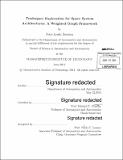| dc.contributor.advisor | Edward F. Crawley. | en_US |
| dc.contributor.author | Davison, Peter Leslie | en_US |
| dc.contributor.other | Massachusetts Institute of Technology. Department of Aeronautics and Astronautics. | en_US |
| dc.date.accessioned | 2014-10-08T15:28:15Z | |
| dc.date.available | 2014-10-08T15:28:15Z | |
| dc.date.copyright | 2014 | en_US |
| dc.date.issued | 2014 | en_US |
| dc.identifier.uri | http://hdl.handle.net/1721.1/90773 | |
| dc.description | Thesis: S.M., Massachusetts Institute of Technology, Department of Aeronautics and Astronautics, 2014. | en_US |
| dc.description | Cataloged from PDF version of thesis. | en_US |
| dc.description | Includes bibliographical references (pages 167-172). | en_US |
| dc.description.abstract | Many systems undergo significant architecture-level change during their lifecycles as a result of exogenous system disturbances (e.g. budget reduction or changes in stakeholder requirements), failure to develop critical technologies, or planned evolution of the system over time. Given the high cost in terms of resources, schedule, and performance of making these changes during system development or operations, it is essential to make these decisions with a thorough understanding of the available options and costs associated with different architecture changes. The analysis of such decisions stems from an understanding of the relationships between architectures in the tradespace, however most architecture tradespace generation tools focus on the modeling and evaluation of individual architectures rather than on modeling how different architectures are related to one another. In this thesis we propose a framework for modeling these relationships based on the evaluation of a pre-existing tradespace for the purpose of analyzing architecture change decisions. This modeling framework is used to discover and evaluate evolutionary pathways through a disorganized tradespace: a process we call tradespace exploration. These pathways can be used to assess architecture selection decisions and to quantitatively compare architecture change decisions against one another, providing a decision analysis tool for system architects. At the core of the framework is the generation of a directed, weighted 'tradespace graph' that serves as a model of the architecture decision making process. Vertices in the tradespace graph are defined by pairings of architectures from the tradespace with asset portfolios, which are the sets of the common elements shared between multiple architectures. The existence of an edge in the graph, which represents a feasible decision to transform from one architecture to another, is determined by the relationship between the asset portfolios of the two vertices. The weight of an edge represents the cost of the corresponding architecture change, with the sum of edge weights along a path through the tradespace representing the total development cost of the architecture evolution. We apply this tradespace exploration framework to two pre-existing architecture tradespaces: the first being the 'HEXANE' tradespace of in-space transportation infrastructures for human exploration beyond low Earth orbit, and the second being the 'SCaN' tradespace of space-based communications network architectures for the relay of data between ground stations and user spacecraft. Using a variety of domain-independent analysis tools and graph search algorithms, we generate several results of potential value to system architects for both applications. | en_US |
| dc.description.statementofresponsibility | by Peter Leslie Davison. | en_US |
| dc.format.extent | 172 pages | en_US |
| dc.language.iso | eng | en_US |
| dc.publisher | Massachusetts Institute of Technology | en_US |
| dc.rights | M.I.T. theses are protected by copyright. They may be viewed from this source for any purpose, but reproduction or distribution in any format is prohibited without written permission. See provided URL for inquiries about permission. | en_US |
| dc.rights.uri | http://dspace.mit.edu/handle/1721.1/7582 | en_US |
| dc.subject | Aeronautics and Astronautics. | en_US |
| dc.title | Tradespace exploration for space system architectures : a weighted graph framework | en_US |
| dc.type | Thesis | en_US |
| dc.description.degree | S.M. | en_US |
| dc.contributor.department | Massachusetts Institute of Technology. Department of Aeronautics and Astronautics | |
| dc.identifier.oclc | 891565382 | en_US |
